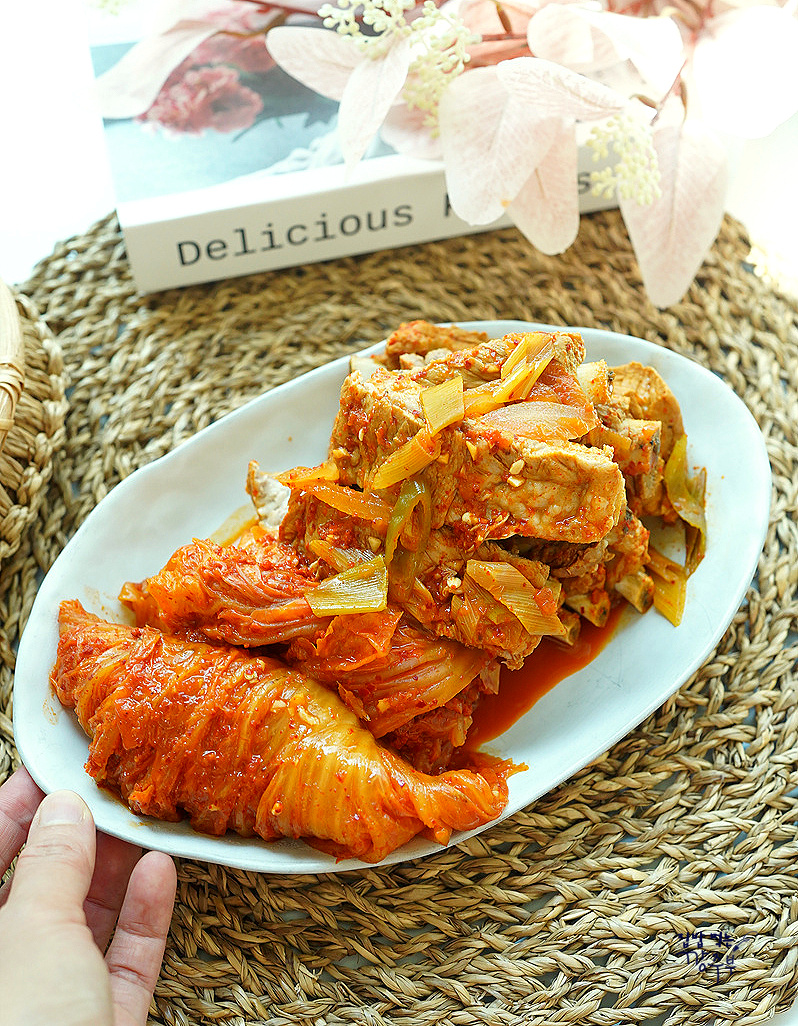Tender & Flavorful Kimchi Pork Rib Stew (Muk Eun Ji Deung Gal Bi Jjim)
Mastering Muk Eun Ji Deung Gal Bi Jjim: A Delicious Recipe with Aged Kimchi and Pork Ribs

One of my absolute favorite dishes is Muk Eun Ji Deung Gal Bi Jjim! I find myself craving it often and making it regularly. With the weather getting warmer and appetites waning, a hearty yet comforting dish like this aged kimchi pork rib stew is the perfect solution. If you have some well-fermented kimchi and about 500g of fresh pork ribs, you can whip up this delightful meal in no time. It might look intimidating, but you’ll be surprised at how easy it is to make at home – you’ll feel like a pro chef! The combination of melt-in-your-mouth tender pork ribs and perfectly aged, warm kimchi is simply divine. It’s a guaranteed rice thief! Follow along and let’s make it together!
Main Ingredients- Pork back ribs 500g
- Water 500ml
- Concentrated stock cubes 1-2 (or dashi broth)
- Half a head of well-fermented aged kimchi
- Onion 1/2 medium
- Green onion 1/2 stalk
- Korean chili pepper 1 (optional)
Pre-cooking Ribs (Blanching)- Soju or cooking wine, a splash
- Bay leaves 1-2
- Whole peppercorns, a pinch
Flavorful Sauce Mixture- Aged kimchi brine 50ml
- Gochugaru (Korean chili powder) 2 Tbsp
- Soy sauce 2 Tbsp
- Fish sauce (anchovy or similar) 1 Tbsp
- Sugar 1 Tbsp (adjust based on kimchi’s sourness)
- Minced garlic 1 Tbsp
- Cooking wine or Mirin 2 Tbsp
- Ginger powder, a pinch (or 1/2 tsp minced fresh ginger)
- Soju or cooking wine, a splash
- Bay leaves 1-2
- Whole peppercorns, a pinch
Flavorful Sauce Mixture- Aged kimchi brine 50ml
- Gochugaru (Korean chili powder) 2 Tbsp
- Soy sauce 2 Tbsp
- Fish sauce (anchovy or similar) 1 Tbsp
- Sugar 1 Tbsp (adjust based on kimchi’s sourness)
- Minced garlic 1 Tbsp
- Cooking wine or Mirin 2 Tbsp
- Ginger powder, a pinch (or 1/2 tsp minced fresh ginger)
Cooking Instructions
Step 1
For fresh pork ribs, pre-soaking to remove blood is not strictly necessary. The blanching step in boiling water will effectively eliminate any gamey odors. If you prefer to pre-soak, you can simply soak them in cold water for about 30 minutes.

Step 2
While the ribs are soaking (if you chose to), let’s prepare the key component: the sauce. In a medium bowl, combine the aged kimchi brine (50ml), gochugaru (2 Tbsp), soy sauce (2 Tbsp), fish sauce (1 Tbsp), sugar (1 Tbsp), minced garlic (1 Tbsp), cooking wine (2 Tbsp), and a pinch of ginger powder.

Step 3
Using a spatula or spoon, stir the sauce ingredients thoroughly until well combined and the sugar has completely dissolved. Ensuring the sugar is dissolved helps the flavors meld evenly into the ribs and kimchi.

Step 4
Now, let’s prep the vegetables. Peel and slice half an onion. Prepare half a stalk of green onion and one Korean chili pepper. If you like it spicier, feel free to add more chili peppers or even a red chili for color.

Step 5
Slice the onion into approximately 0.5cm thick strips. Cut the green onion and chili pepper on a diagonal (bias cut). This prepares them to cook evenly and adds a nice visual touch to the dish.

Step 6
To effectively remove any gamey smell from the ribs, we’ll blanch them first. Fill a pot with enough water to cover the ribs, add a splash of soju or cooking wine, 1-2 bay leaves, and a pinch of whole peppercorns. If you don’t have these, dissolving a tablespoon of doenjang (soybean paste) in the water also works well. Bring the water to a boil, add the ribs, and blanch for about 5 minutes to remove impurities.

Step 7
After blanching, rinse the ribs briefly under cold running water to wash away any residue. Then, in the pot you’ll be stewing in, lay down a base layer of the sliced onions. This prevents the bottom from scorching and adds a subtle sweetness.

Step 8
Arrange the blanched pork ribs on top of the onions. Then, generously spread the half-head of aged kimchi over the ribs. The kimchi will infuse the ribs with its rich, fermented flavor.

Step 9
Pour all of the prepared sauce mixture evenly over the kimchi and ribs. Make sure to coat everything well so the flavors penetrate deeply.

Step 10
Add 500ml of water to the pot. This liquid will help braise the ingredients and create a delicious broth.

Step 11
For an extra boost of umami, add 1-2 concentrated stock cubes. Using dashi broth instead is also a great option.

Step 12
Cover the pot and let it simmer gently over medium-low heat for about 40 minutes, or until the ribs are very tender. Spooning some of the broth over the ingredients occasionally will help distribute the flavors. This dish is remarkably simple – you essentially just combine everything and let it cook! Even beginner cooks can achieve fantastic results. Give it a try; it’s a wonderful dish to share with your family!




